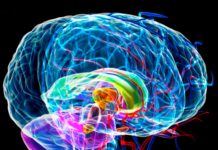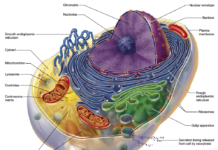Brain Survival Strategies
By Ward Dean, MD and Jim English
Across the globe, millions of people start the New Year by heading to the local gym. Some aim to lose those sagging excess pounds that seem to reappear after the holidays. Others hope to revitalize lagging energy levels, stave off the effects of advancing age, and reduce their risk of developing degenerative diseases.
Unfortunately, despite all the known benefits physical exertion confers (including increased life span and improved quality of life), no amount of exercise can address the greatest challenge facing contemporary aging adults: the prospect of having one’s body out-last one’s brain.
The human brain controls all life systems, and as the body ages, so does the brain. Traditional health care has promoted the concept that it is entirely normal and acceptable to experience declines in mental performance with advancing age.
This concept is slowly being discarded as health-care professionals begin to cope with the alarming increase in the number of patients suffering from age-related cognitive dysfunction, dementia and memory impairment. This problem is further exacerbated by an alarming increase in the incidence of Alzheimer’s disease, Parkinson’s disease and age-related mental decline. For example, Alzheimer’s, a progressive degenerative disease that commonly appears after the age of 50, is the most common cause of dementia and one of the most feared threats to mental health and cognitive performance.
Alzheimer’s currently afflicts one person in ten over the age of 65, and nearly half of all individuals over the age of 85. It is estimated that over four million people in the US, and an estimated 12 million people worldwide, now have Alzheimer’s. These numbers are expected to almost double in the coming decades, further draining already strained health care resources, leaving almost no family untouched. (1)
Hope for Aging Brains
Researchers and pharmaceutical companies are pouring vast resources into developing new diagnostic methods and treatments for Alzheimer’s and other degenerative brain conditions. Research in the field of human memory has shown that there are a number of drugs and nutritional compounds that can support healthy brain function and help us maintain and prolong our capacity to think and reason.
Double-blind controlled trials conducted in Europe and the US support the role of several nutritional supplements and drugs in slowing down the age-related loss of higher-level cognitive functions. These changes can appear in healthy individuals as young as 50 years of age.
This article reviews some of the most promising and potent anti-aging therapies for protecting our 10 billion brain cells. Combined with lifestyle habits known to influence mental health, such as eating a healthy diet, exercising regularly, and reducing stress and exposure to environmental pollutants, these strategies can help preserve brain function and contribute to an improved quality of life.
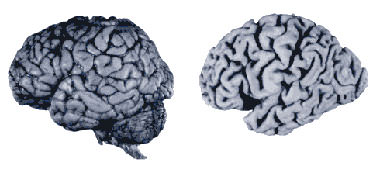
Fig. 1. Comparison of healthy brain (left) with age-matched brain damaged from Alzheimer’s reveals damage and loss of tissue.
Huperzine
Huperzine is a unique nutritional supplement that offers hope to those suffering from Alzheimer’s disease and other age-related mental conditions. Alzheimer’s is characterized by the destruction of nerve cells in several key areas of the brain devoted to mental functions, including a substantial loss of presynaptic cholinergic neurons in brains of patients. (2)
This results in a dramatic decrease in the neurotransmitter acetylcholine, a vital neurotransmitter with a fundamental role in memory and intracellular communication between nerve cells. Research has shown that levels of acetylcholine are deficient in the brains of patients with Alzheimer’s disease. What little acetylcholine is still produced in the patient’s brain is quickly broken down by the brain enzyme, acetylcholinesterase (AChE), leading to a shortage of the neurotransmitter, contributing to the patient’s loss of memory and other cognitive functions.
Huperzine is derived from the ancient Chinese herb Huperzia serrata, traditionally used to treat fever, inflammation and irregular menstruation. In the late 1980s, researchers discovered that Huperzine-A, an alkaloid extracted from the raw plant, readily crosses the blood-brain barrier to prevent acetylcholinesterase (AChE) from destroying acetylcholine.
Researchers found that Huperzine works in a manner similar to the AChE inhibitors (such as tacrine and donepezil) to impair the ability of AChE to degrade acetylcholine. (3) By inhibiting the actions of AChE and increasing acetylcholine concentrations in the brain, Huperzine-A has been shown to be effective in alleviating some of the symptoms associated with acetylcholine deficiencies.
“Hup-A appears to bind more tightly and specifically to acetylcholinesterase than the other AChE inhibitors,” crystallographer Prof. Joel Sussman, one of the authors of the study said. “It is as if this natural substance were ingeniously designed to fit into the exact spot in AChE where it will do the most good.”
Researchers have demonstrated that patients suffering from Alzheimer’s and various other memory disorders gain significant benefit from huperzine, both in terms of memory and life quality. In one placebo-controlled, double-blinded study, researchers found that 58% of Alzheimer’s patients experience significant improvement in both cognitive and memory function when given 200 mcg of Huperzine per day. (4)
Other significant effects have been noted in patients, both in terms of their life quality and their ability to retrieve past memories. Huperzine’s memory-enhancing properties suggest that it may be an effective agent for improving memory and learning in healthy humans as well. These findings suggest that Huperzine not only protects from the effects of Alzheimer’s and senile memory deficits, but also provides a unique and exciting supplement for supporting memory in the healthy aging human as well.
Acetyl-L-Carnitine
Acetyl-L-Carnitine (ALC) is a cognitive enhancer and neuroprotective agent that protects against a wide range of age-related degenerative changes in the brain and nervous system. ALC is an ester of carnitine that modulates cellular concentrations of free coenzyme A and acetyl-coenzyme A, two compounds integrally involved in numerous cellular functions, including the transfer of fatty acids across mitochondrial membranes for energy production.
ALC is found in various concentrations in the brain and its levels are significantly reduced with aging. (7) ALC also significantly reduces damaged fats, such as lipofuscin, in the brains of aged rats. In addition to accumulating in the aging brain, lipofuscin also accumulates in the skin as ‘aging spots,’ those brownish pigmented blemishes that accumulate in the backs of hands of many people over fifty. (5) The reduction of these deposits following consumption of ALC may be evidence of a slowing in the aging process in the brain.
ALC also has the ability to cross into the brain where it acts as a powerful antioxidant, preventing the deterioration of brain cells that normally occurs with age. Because of this protective effect, ALC may be beneficial in the prevention and treatment of free-radical mediated diseases, such as Alzheimer’s and Parkinson’s disease. (6)
- Alzheimer’s Disease: As mentioned earlier, Alzheimer’s disease primarily effects cholinergic function. ALC has been shown to promote both the release (8) and synthesis (9) of acetylcholine. Additionally, ALC promotes high affinity uptake of choline, which declines significantly with age. (10)
- Parkinson’s Disease: In addition to ALC’s cholinergic-enhancing properties, researchers have shown that ALC has numerous beneficial effects on dopaminergic neurons. (11) The decline of the dopaminergic neurotransmission system is most evident in Parkinson’s disease patients.
ALC has been shown to improve age-related changes of dopamine receptors, including improved release and binding of dopamine. Research has shown that ALC can prevent dopaminergic neuron death caused by MPTP, a neurotoxin that mimics neurological symptoms similar to Parkinson’s disease by selectively killing dopaminergic neurons. (12) - Restoring NMDA Receptors: The NMDA (N-Methyl-D-Aspartic acid) receptor system is one of the most important receptor systems involved with cognitive function and memory. NMDA receptors are widely distributed in the brain, and their effects are mediated by excitatory amino acids like glutamate. It has been shown that the density of NMDA receptors declines with age. Damage to the NMDA receptors is also the most severe adverse effect of the street drug, Ecstasy (MDMA). Treatment with ALC restores NMDA receptor numbers to a significant degree. (13) In fact, even a single dose of ALC can significantly increase the number of available NMDA receptors.
- Reversing Neuroendocrine Aging: One of the most important, and often overlooked, receptor systems is that of glucocorticoids. The hypothalamus in the brain is the site of negative feedback between the pituitary and adrenal gland. This is the center that regulates the production of glucocorticoids (principally, cortisol) by the adrenals. The number of glucocorticoid receptors in the hypothalamus declines significantly with age, (14) and this results in an imbalance in the hypothalamus-pituitary-adrenal (HPA) axis.
ALC treatment has been shown to prevent this age-related decline in receptor number. (15) Because these receptors are central to neuroendocrine aging, their decrease is considered a consistent marker for aging. It appears that ALC may have substantial potential for helping to slow the degradation of this principle marker of neuroendocrine aging. - Restoring Nerve Growth Factor Function: One of the most exciting areas of brain research has been the functions of Nerve Growth Factor (NGF). NGF mediates many of its effects through a receptor system (NGF receptor system). Unfortunately, aging is associated with a significant drop in the number of NGF receptors in certain brain regions, as well as a decrease in the amount of NGF produced. Because NGF is important for the growth and continued maintenance of neurons, the age-related decline in NGF function is thought to be directly involved in brain aging.
ALC has the ability to partially reverse both of these changes, and has even been shown to positively effect both neuronal survival and growth. (16) ALC’s ability to enhance NGF effects suggests a tremendous potential for this natural compound in many diseases and conditions affecting the brain and nervous system. - Restoring Mitochondrial Enzyme Activity and Cardiolipin to more Youthful Levels: A group of Italian scientists (Paradies, et al, 1994) evaluated the effect of dietary ALC on the mitochondrial membranes of young and old rats. They found that the activity of the enzyme, cytochrome c oxidase, declined about 30% in the old rats, compared to the young. This may explain the reduction in ATP formation (and reduced energy) with age. The scientists found that dietary ALC restored cytochrome c oxidase activity in old rats to that of the younger animals (Fig. 2).
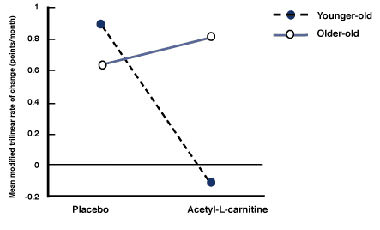
Fig. 2. Acetyl-L-carnitine benefit for the “younger-old” over the “older-old” in Alzhheimer’s disease, as elucidated by tri-linear analysis. The lind trending downward indicates deterioration, while the line upward indicates improvement. (from Brooks et al).
Furthermore, in a follow-up study, they found that the activity of another enzyme, the ADP carrier protein adenine nucleotidase (ANT) also decreases with age. Decreased ANT can also result in reduced production of ATP. The scientists again found that ALC restored ANT activity to more youthful levels.
Finally, the same scientists found that mitochondrial levels of cardiolipin, a key lipid subfraction, were also much improved (Fig.3). In fact, they hypothesized that this dramatic improvement in cardiolipin fraction was the key element in its other demonstrated benefits.
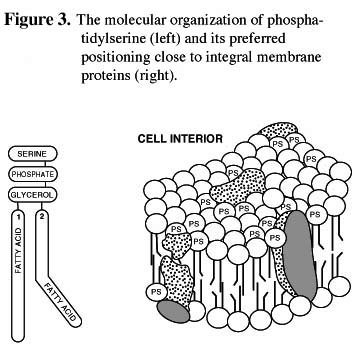
The authors concluded that restoration of these functions to youthful levels should allow more efficient oxidative phosphorylation, thereby improving performance in aged animals.
Phosphatidylserine (PS)
Phosphatidylserine (PS) is a naturally-occurring phospholipid nutrient that has been shown to improve cognitive functions and enhance mental ability. PS is essential to the healthy functioning of the human brain where it affects an assortment of nerve cell functions, including: conduction of nerve impulses; accumulation, storage and release of neurotransmitters; the activity and number of receptors involved in synaptic discharge; and the biological maintenance of cellular ‘housekeeping’ functions.
Supplementation of the diet with PS has been proven to slow, halt, or in many cases, even reverse cognitive degeneration due to Age-Related Cognitive Decline (ARCD), (18,19,24) and dementing illnesses like Alzheimer’s disease. (17,20-23,25) PS has been scientifically established to be among the most effective substances to consistently result in dramatic cognitive improvements and enhancements of other higher brain functions.
PS is extremely bioavailable and crosses the blood-brain barrier with ease. Once in the brain, the PS molecule as a unit merges smoothly into the nerve cell membrane where it is available to facilitate cell-level energy and homeostasis, as well as enhance neurotransmitter production, release, and action. PS also serves as a precursor reservoir for the related phospholipids, phosphatidylethanolamine and phosphatidylcholine.
Findings from many controlled clinical trials indicate that PS consistently ameliorates memory loss and other cognitive decline related to aging. (33) In 14 double-blind clinical trials, conducted with subjects aged 50 and older, PS benefited all degrees of cognitive impairment. (17-20,21-26,28-30) In one US trial by Crook, et al (1991) on subjects with age-related cognitive decline (ARCD), (19) PS reversed the decline of name-face acquisition skills by a statistical 12 years; i.e., from average scores attained by 64-year-old subjects to average scores attained by 52-year-olds. As the investigators noted, it’s as if they had ‘rolled back the clock’ measuring ‘cognitive biological age’ by roughly 12 years, in terms of overall cognitive status.
In double-blind trials conducted with more severely afflicted subjects, PS brought about statistically and clinically significant improvements in measures of recall, learning, concentration, adaptability, mood and sociability. In other double-blind trials, PS improved neuro-physiological measures such as EEG (electroencephalogram) and reflexes (as judged by flicker-fusion response time). (31)
In another human trial conducted with young male volunteers, PS significantly improved EEG alpha rhythm (which often declines with aging and memory loss). (31) In older subjects with severe cognitive impairment, PS dramatically enhanced brain glucose consumption (assessed via positron emission tomographic [PET] imaging) and partially restored the 24-hour rhythm of TSH (thyroid-stimulating hormone) secretion in aged men. (32) Also, in elderly subjects, PS enhanced the hypothalamic-pituitary-adrenal (HPA) stress-coping axis, as assessed by the dexamethasone suppression test. (27)
Vinpocetine
Vinpocetine is a powerful memory-enhancer that facilitates cerebral metabolism by improving cerebral microcirculation, stepping up brain cell ATP production, and increasing utilization of glucose and oxygen. Vinpocetine has the unique ability to selectively increase blood flow to the brain, particularly improving blood flow to the impaired area, without lowering blood flow to other parts of the body.
Because of its selective effects on improving cerebral circulation, vinpocetine is often used for the treatment of cerebral circulatory disorders such as memory problems, acute stroke, aphasia (loss of the power of expression), apraxia (inability to coordinate movements), motor disorders, dizziness and other cerebro-vestibular (inner-ear) problems, and headache.
In a series of studies involving 882 patients with neurological disorders ranging from stroke to cerebral insufficiency, vinpocetine was found to confer significant improvements in 62% of the patients. In one of the studies, cerebral insufficiency patients were asked to memorize a list of 10 words. Without vinpocetine the subjects were able to memorize an average of six words. After a month of treatment the average went up to 10 words. (34)
Reactive oxygen species (ROS) are believed to play a crucial role in the neuronal damage occurring in ischemic injury (stroke) and neurodegenerative disorders. Researchers at the Center for Neurosciences in Portugal performed animal studies to examine the antioxidant effects of vinpocetine to prevent the formation of ROS and lipid peroxidation in brain synaptosomes. They found that vinpocetine significantly decreased oxidative stress and inhibited ROS formation up to 83%. The researchers concluded that the antioxidant effects of vinpocetine contributed to reducing neuronal damage in pathological situations. (35)
Conclusion
Baby boomers and other aging adults face a loss of cognitive powers and impaired mental functions. Even otherwise healthy aging adults may expect to experience noticeable declines in mental abilities. Research supports the role of a number of potent anti-aging therapies that pay multiple dividends in helping us maintain our identity, while acting to slow brain aging and preserve cognitive function.
Rather than waiting for signs of an irreversible decline in mental abilities or other, more serious cognitive problems, it would be prudent to take steps to support the brain’s ability to heal and self-repair. In short, we can take steps now to slow age-dependent brain cell changes, preserve vital functions, and maintain good health and vigor. To paraphrase, the mind is a terrible thing to waste.
References
1. Alzheimer’s Association, General Statistics and Demographics, www.alz.org/hc/overview/stats.htm.
2. Watkins PB, Zimmerman HJ, Knapp MJ. Hepatotoxic effects of tacrine administration in patients with Alzheimer’s disease. JAMA 1994 Apr 6; 271:992-8
3. Raves ML, Harel M, Pang YP, Silman I, Kozikowski AP, Sussman JL. Structure of acetylcholinesterase complexed with the nootropic alkaloid, (-)-huperzine A. Nat Struct Biol 1997 Jan;4(1):57-63.)
4. Xu SS; Gao ZX; Weng Z; Du ZM; Xu WA; Yang JS; Zhang ML; Tong ZH; Fang YS; Chai XS; et al, Efficacy of tablet huperzine-A on memory, cognition, and behavior in Alzheimer’s disease. Chung Kuo Yao Li, Hsueh Pao16:391-5, 1995.)
5. Ramacci MT, De Rossi M, Lucreziotti MR, Mione MC, Amenta F. Effect of long-term treatment with acetyl-L-carnitine on structural changes of aging rat brain. Drugs Exp Clin Res 1988;14(9):593-601.)
6. Puca FM, Genco S, Specchio LM, et al. Clinical pharmacodynamics of acetyl-L-carnitine in patients with Parkinson’s disease. Int J Clin Pharmacol Res 1990;10(1-2):139-43.)
7. F. Maccari, A. Arseni, P. Chiodi, et al, Exp Geront 1990; 25: 127-134.) In numerous animal studies ALC has been shown to have the remarkable ability of improving not only cognitive changes, but also morphological (structural) and neurochemical changes. ALC has varied effects on cholinergic activity.
8. A. Imperato, M.T. Ramacci, L. Angelucci, et al, Neurosci Lett 1989; 107: 251-255.)
9. V. Dolezal and S. Tucek, J Neurochem 1981; 36: 1323-1330.
10. D. Curti, F. Dagani, M.R. Galmozzi, et al, Mech Ageing Dev 1989; 47: 39-45.
11. H. Sershen, L.G. Harsing, M. Banay-Schwartz, et al, J Neurosci Res 1991; 30: 555-559.
12. Bodis-Wollner, E. Chung, M.F. Ghilardi, et al, J Neural Transm Park Dis Diment Sci 1991; 3: 63-72.
13. L. Fiore and L. Rampello, Acta Neurol 1989; 11: 346-350.
14. R.M. Sapolsky, L.C. Krey, and B.S. McEwen, J Neurosci 1985; 5: 1222-1227.
15. F.R. Patacchioli, F. Amenta, M.T. Ramacci, et al, J Neurosci Res 1989; 23: 462-466.
16. G. Taglialetela, L. Angelucci, M.T. Ramacci, et al, Brain Res Dev Brain Res 1991; 59: 221-230
17. Amaducci, L and the SMID Group. ‘Phosphatidylserine in the treatment of Alzheimer’s disease: results of a multicenter study.’ Psychopharmacol. Bulletin, 1988, 24: 130-4.
18. Cenacchi, B, Bertoldin T, Farina C, Fiori M.G., Crepaldi G. ‘Cognitive decline in the elderly: a double-blind, placebo-controlled multicenter study on efficacy of phosphatidylserine administration.’ Aging (Clin. Exp. Res.), 1993, 5: 123-33.
19. Crook, T.H., Tinklenburg, J, Yesavage J, Petrie W, Nunzie M.G., and Massari, D.C. ‘Effects of phosphatidylserine in age-associated memory impairment.’ Neurol, 1991. 41: 644-9.
20. Crook, T.H., Petrie W, Wells C, Massari, D.C. ‘Effects of phosphatidylserine in Alzheimer’s disease.’ Psychopharmacol. Bulletin,, 1992. 28: 61-6.
21. Delwaide, P.J., Gyselynk-Mambourg A.M., Hurlet A. and Ylieff M. ‘Double-blind randomized controlled study of phosphatidylserine in demented patients.’ Acta Neurol. Scand, 1986. 73:136-40.
22. Engel, R.R., Satzger W, Gunther W, Kathmann N, Bove D, Gerkes, Munch U and Hippius H. ‘Double-blind cross-over study of phosphatidylserine vs. placebo in subjects with early cognitive deterioration of the Alzheimer type.’ Eur. Neuropsychopharmacol, 1992. 2: 149-55.
23. Funfgeld, E.W., Baggen, M, Nedwidek, P, et al. ‘Double-blind study with phosphatidylserine (PS) in Parkinsonian patients with senile dementia of Alzheimer’s type (SDAT).’ Progr. Clin. Biol. Res, 1989. 317: 1235-46.
24. Gindin, J, et al., 1995. The Effect of Plant Phosphatidylserine on Age-Associated Memory Impairment and Mood in the Functioning Elderly. Rehovot, Israel: Geriatric Institute for Education and Research, and Department of Geriatrics, Kaplan Hospital.
25. Hershowitz M, et al. ‘Long-term treatment of dementia Alzheimer type with phosphatidylserine: effect on cognitive functioning and performance in daily life.’ In, Bazan NG, et al (eds.) Phospholipids in the Nervous System: Biochemical and Molecular Pathology, 1989. Padua, Italy: Liviana Press.
26. Maggioni, M, Picotti, G.B., Bondiolotti,G.P., Panerai, A. Cenacchi, T. Nobil, P. and Brambilla, F. ‘Effects of phosphatidylserine therapy in geriatric patients with depressive disorders.’ Acta Psychiatr. Scand. 1990. 81: 265-70.
27. Monteleone, P, Maj, M, Beinat, L, Natale, M, and Kemali, D. ‘Blunting by chronic phosphatidylserine administration of the stress-induced activation of the hypothalamos-pituitary-adrenal axis in healthy men.’ Eur. J. Clin. Pharmacol,1992. 41: 385-8.
28. Nerozzi, D., et al. ‘Phosphatidylserine and impaired memory in the elderly.’ La Clinica Terapeutica, 1989. 120: 399-404. [Translated from the Italian]
29. 15 Palmieri, G, Palmieri, R, Inzoli, M.R., et al. ‘Double-blind controlled trial of phosphatidylserine in patients with senile mental deterioration.’ Clin. Trials J., 1987. 24: 73-83.
30. Ransmayr, G, Plorer, S, Gerstenbrand, F, and Bauer, G. ‘Double-blind placebo-controlled trial of phosphatidylserine in elderly patients with arteriosclerotic encephalopathy.’ Clin. Trials J., 1987. 24: 62-72.
31. Rosadini, G, Sannita,W.G., Nobili, F, and Cenacchi, T. ‘Phosphatidylserine: quantitative EEG effects in healthy volunteers.’ Neuropsychobiol, 1991. 24: 42-8.
32. Kidd, P., 1995. Phosphatidylserine (PS), A Remarkable Brain Cell Nutrient. Lucas Meyer, Inc, Decator, Il.
33. Dean, W., Morgenthaler, J. Fowkes, S. 1993 ‘Phosphatidylserine’ Smart Drugs II, The Next Generation, Health Freedom Publications. Menlo Park, CA. pp. 75-80.
34. Gedeon Richter product literature, Cavinton.
35. Santos MS, Duarte AI, Moreira PI, Oliveira CR Synaptosomal response to oxidative stress: effect of vinpocetine. Free Radic Res 2000 Jan;32(1):57-66.











